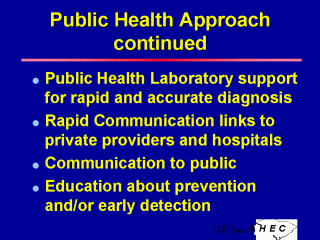| front |1 |2 |3 |4 |5 |6 |7 |8 |9 |10 |11 |12 |13 |14 |15 |16 |17 |18 |19 |20 |21 |22 |23 |24 |25 |26 |27 |28 |29 |30 |31 |32 |33 |34 |35 |review |
 |
Laboratory support is required for rapid and accurate diagnosis of an outbreak or unusual disease. Sometimes a definitive diagnosis may not be possible immediately. Clinical signs and symptoms of the illness may be the only information available from which to develop a differential diagnosis. Rapid communication links must be established with private medical providers and hospitals to alert them to outbreaks and disease changes as well as to facilitate collaboration, communication, and coordination. Communication with media is essential to inform the public and provide accurate information for action and prevention. Aggressive education of health care providers and the community about prevention or early identification and detection. Information should include a list of signs and symptoms, and guidelines for prophylactic treatment, protective clothing, or other personal protection. For example, during/following a hurricane, information about food spoilage and unclean water is widely disseminated along with tips on what to do with food in freezers that were without power - all in an effort to prevent secondary food and water-borne diseases in the midst of a disaster. Similarly, tetanus vaccinations are provided in flood areas where risk of a dirty injury is greater. |
| front |1 |2 |3 |4 |5 |6 |7 |8 |9 |10 |11 |12 |13 |14 |15 |16 |17 |18 |19 |20 |21 |22 |23 |24 |25 |26 |27 |28 |29 |30 |31 |32 |33 |34 |35 |review |